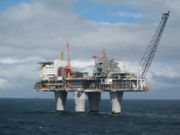
Vacuum-anchor
Encyclopedia

Civil engineering
Civil engineering is a professional engineering discipline that deals with the design, construction, and maintenance of the physical and naturally built environment, including works like roads, bridges, canals, dams, and buildings...
, vacuum-anchors are ocean bottom fasteners used to anchor deep seas oil platforms (example: See Troll A Oil Platform
Troll A platform
The Troll A platform is a condeep offshore natural gas platform in the Troll gas field off the west coast of Norway. It is the tallest construction that has ever been moved to another position, relative to the surface of the Earth, and is among the largest and most complex engineering projects in...
) and other gravity base technology
Gravity base structure
A gravity-based structure is a support structure held in place by gravity. A common application for a GBS is an offshore oil platform. These structures are often constructed in fjords since their protected area and sufficient depth are very desirable for construction...
based structures in the soupy soft bottomed muck found on many oil bearing continental shelves and the world's shallower seas. Gravity based anchor legs flare out forming a wider footprint where they contact the bottom much as the webbed feet of many aquatic animals increase the surface area above the vacuum-anchors which are open ended long cylindrical shaped deep cups with a sealed top end closed by a valve which connects and anchors mechanically to the legs of the gravity based structure. The valve is used to exhaust any gases and liquid which seeks to escape the trapped sea bottom materials entering the open end of the anchor.
Physically, these are the upscaled analog of a tall drinking glass filled with water then turned upside down and secured in place bottom-side-up. When a lifting or sideways force is applied to such a container, the weight
Weight
In science and engineering, the weight of an object is the force on the object due to gravity. Its magnitude , often denoted by an italic letter W, is the product of the mass m of the object and the magnitude of the local gravitational acceleration g; thus:...
and inertia
Inertia
Inertia is the resistance of any physical object to a change in its state of motion or rest, or the tendency of an object to resist any change in its motion. It is proportional to an object's mass. The principle of inertia is one of the fundamental principles of classical physics which are used to...
of the enclosed mass (The mushy gravel, mud, water, and rock solution of the sea bed) must also be displaced (lifted or moved sideways) which anchors them firmly in place within the surrounding materials of the soft bottom. When lifted, any enclosed material attempting to spill out of the enclosure creates a vacuum, just as does the container in the kitchen sink, giving the anchor their name.
Six to seven 40 m tall, 20 m diameter steel vacuum-anchor cylinders
Cylinder (geometry)
A cylinder is one of the most basic curvilinear geometric shapes, the surface formed by the points at a fixed distance from a given line segment, the axis of the cylinder. The solid enclosed by this surface and by two planes perpendicular to the axis is also called a cylinder...
are used to anchor the four legs of the troll A platform depicted above. The Troll A platform stands on the sea floor 303 metres (994.1 ft) below the surface of the sea and each of the continuous-slip-formed
Slip forming
This article is about pouring concrete in moving forms. See Slipform stonemasonry for another type of slip forming.Slip forming, continuous poured, continuously formed, or slipform construction is a construction method in which concrete is poured into a continuously moving form...
concrete cylindrical legs has an elevator that takes over nine minutes to travel from the platform above the waves to the sea floor.

